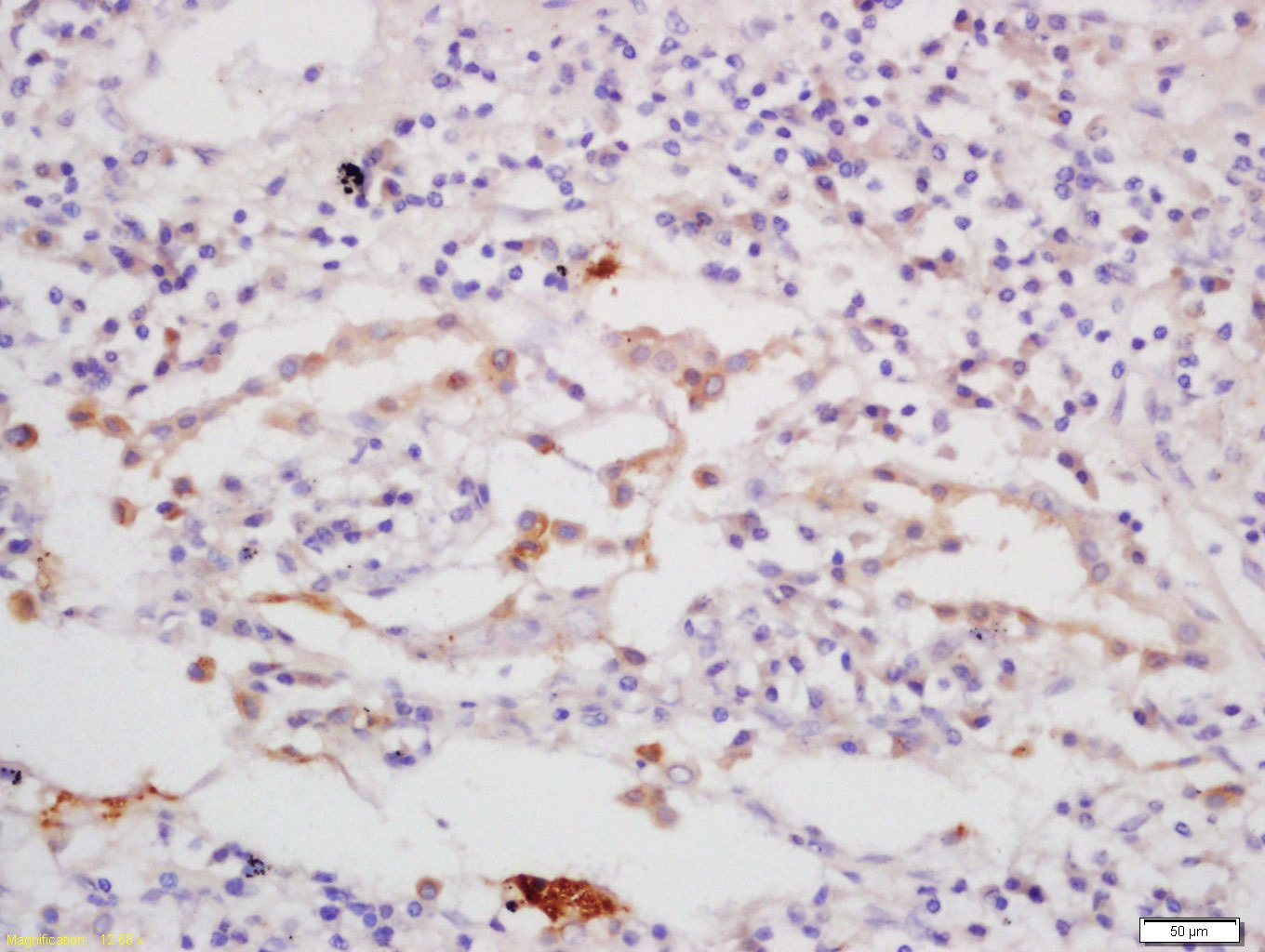Shopping Cart
Remove All Your shopping cart is currently empty
Your shopping cart is currently empty
Anti-CGAS Polyclonal Antibody is a Rabbit antibody targeting CGAS. Anti-CGAS Polyclonal Antibody can be used in ELISA,IF,IHC-Fr,IHC-P.
| Pack Size | Price | USA Warehouse | Global Warehouse | Quantity |
|---|---|---|---|---|
| 50 μL | $220 | 7-10 days | 7-10 days | |
| 100 μL | $373 | 7-10 days | 7-10 days | |
| 200 μL | $528 | 7-10 days | 7-10 days |
| Description | Anti-CGAS Polyclonal Antibody is a Rabbit antibody targeting CGAS. Anti-CGAS Polyclonal Antibody can be used in ELISA,IF,IHC-Fr,IHC-P. |
| Synonyms | MB21D1, Mab-21 domain-containing protein 1, h-cGAS, Cyclic GMP-AMP synthase, cGAS, cGAMP synthase, C6orf150, 2'3'-cGAMP synthase |
| Ig Type | IgG |
| Reactivity | Human (predicted:Mouse,Rat) |
| Verified Activity | Tissue/cell: human lung carcinoma; 4% Paraformaldehyde-fixed and paraffin-embedded; Antigen retrieval: citrate buffer (0.01M, pH6.0), Boiling bathing for 15 min; Block endogenous peroxidase by 3% Hydrogen peroxide for 30 min; Blocking buffer (normal goat serum) at 37°C for 20 min; Incubation: Anti-C6orf150 Polyclonal Antibody, Unconjugated (TMAB-00419) 1:200, overnight at 4°C, followed by conjugation to the secondary antibody and DAb staining.  |
| Application | |
| Recommended Dose | IHC-P: 1:100-500; IHC-Fr: 1:400-800; IF: 1:100-500; ELISA: 1:5000-10000 |
| Antibody Type | Polyclonal |
| Host Species | Rabbit |
| Subcellular Localization | Cytoplasm, cytosol. |
| Tissue Specificity | Expressed in the monocytic cell line THP1. |
| Construction | Polyclonal Antibody |
| Purification | Protein A purified |
| Appearance | Liquid |
| Formulation | 0.01M TBS (pH7.4) with 1% BSA, 0.02% Proclin300 and 50% Glycerol. |
| Concentration | 1 mg/mL |
| Research Background | Making up nearly 6% of the human genome, chromosome 6 contains around 1,200 genes within 170 million base pairs of sequence. Deletion of a portion of the q arm of chromosome 6 is associated with early onset intestinal cancer suggesting the presence of a cancer susceptibility locus. Porphyria cutanea tarda is associated with chromosome 6 through the HFE gene which, when mutated, predisposes an individual to developing this porphyria. Notably, the PARK2 gene, which is associated with Parkinson's disease, and the genes encoding the major histocompatiblity complex proteins, which are key molecular components of the immune system and determine predisposition to rheumatic diseases, are also located on chromosome 6. Stickler syndrome, 21-hydroxylase deficiency and maple syrup urine disease are also associated with genes on chromosome 6. A bipolar disorder susceptibility locus has been identified on the q arm of chromosome 6. The C6orf150 gene product has been provisionally designated C6orf150 pending further characterization. |
| Immunogen | KLH conjugated synthetic peptide: human C6orf150 |
| Antigen Species | Human |
| Gene Name | CGAS |
| Gene ID | |
| Protein Name | Cyclic GMP-AMP synthase |
| Uniprot ID | |
| Biology Area | Other Antibodies |
| Function | Nucleotidyltransferase that catalyzes the formation of cyclic GMP-AMP (cGAMP) from ATP and GTP. Catalysis involves both the formation of a 2,5 phosphodiester linkage at the GpA step and the formation of a 3,5 phosphodiester linkage at the ApG step, producing c[G(2,5)pA(3,5)p]. Has antiviral activity by acting as a key cytosolic DNA sensor, the presence of double-stranded DNA (dsDNA) in the cytoplasm being a danger signal that triggers the immune responses. Binds cytosolic DNA directly, leading to activation and synthesis of cGAMP, a second messenger that binds to and activates TMEM173/STING, thereby triggering type-I interferon production. cGAMP can be transferred between cells by virtue of packaging within viral particles contributing to IFN-induction in newly infected cells in a cGAS-independent but TMEM173/STING-dependent manner (PubMed:26229115). (Microbial infection) Upon M.tuberculosis infection THP-1 cells knocked-out for this gene have impaired type-I interferon production (IF-1 beta), nor do they produce type-I IFN upon transfection with dsDNA (PubMed:26048138). |
| Molecular Weight | Theoretical: 59 kDa. |
| Stability & Storage | Store at -20°C or -80°C for 12 months. Avoid repeated freeze-thaw cycles. |
| Transport | Shipping with blue ice. |
| Size | Quantity | Unit Price | Amount | Operation |
|---|

Copyright © 2015-2025 TargetMol Chemicals Inc. All Rights Reserved.